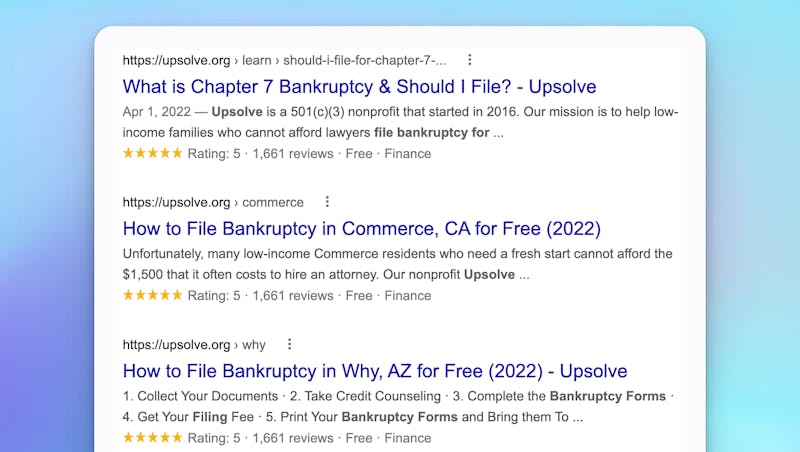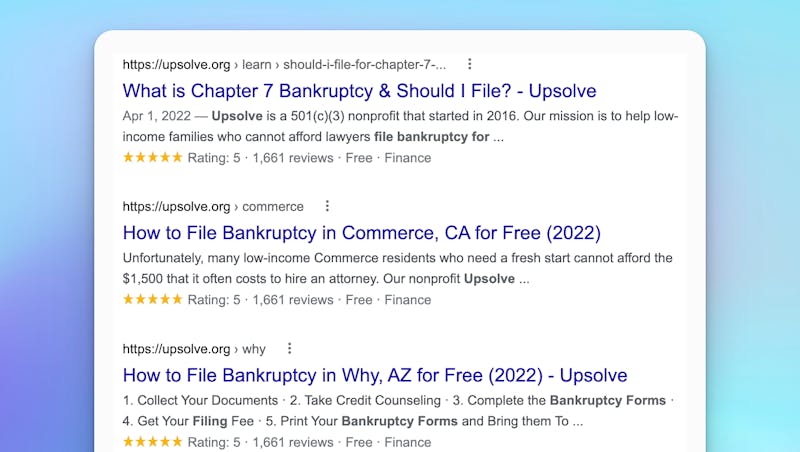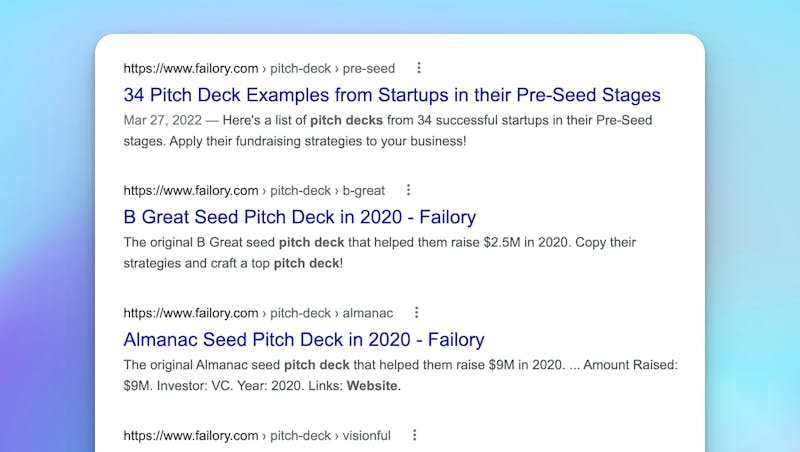Digital marketing tends to get more competitive, and SEO continues to become increasingly complex with each passing year. This is why programmatic SEO has become quite popular among companies looking to increase website organic traffic without sacrificing time and effort. Therefore, if you want your company to stand out, you should consider using this content creation strategy for search engine optimization.
In this article, we will give you a brief about what programmatic SEO is and how you can implement it to boost organic search traffic.
What is Programmatic SEO?
Programmatic SEO or pSEO for short, is a process to automate and scale your content creation by generating hundreds or thousands of landing pages using templates that can dynamically insert data from a dataset. Programmatic SEO aims to drive traffic to your website and rank organically on search results on low-competition/long-tail keywords.
In simple terms, building landing pages from a spreadsheet to rank higher in Google search results. With pSEO, you can automate content creation to rank for low-competition organic keywords. This results in generating high-quality traffic to your website, getting as many people as possible to click on your links, and then redirecting your website visitor to your homepage or pricing page.
It's also a means to avoid the time-consuming process of building and optimizing individual page. It is less about authoritative, informative, or excellent content and more about generating a positive user experience and high-volume landing pages with transactional intent.
Now that we've piqued your interest, let's take a look at why you should use a programmatic SEO strategy.
What are the benefits of programmatic SEO?
With programmatic SEO strategies, you can capture hundreds and thousands of niche search results and business searches. There's also the possibility of automating the most painful part of SEO i.e, create content.
A good example of pSEO in action is on sites like TripAdvisor. Leveraging this SEO technique, the company has been able to create landing pages for everything travel-related.
When someone searches for a travel-related keyword like “Things to do in London”, there's a high probability that TripAdvisor has produced a landing page that captures those searchers from search engines to their website.
Another advantage pSEO has is that it helps with publishing 100s or 1000s programmatic pages at scale. Still using TripAdvisor as an example, we discovered that most info on their site are grouped under topic types like “Things to do”, “Restaurants to visit”, “Airlines”, or “Hotels”.
For instance, if someone tries to run a search for Amsterdam, Tripadvisors will serve pages that cut across all topic types, just as seen in the image below:

As you can see, creating these variations for each city in the world will end up running into thousands of programmatic pages. Can they manually handle such content volume?
They could, but it will take years to achieve if done manually. Instead, they created these programmatically generated pages with the same design and content structure within a few months. Done right, an effective pSEO strategy can turn your side hustle into a profitable online business in months instead of years.
Entrepreneurs mostly use this tactic for their startups, affiliates in digital marketing for growing their niche sites, and SEO managers for their clients or employers. Companies such as Zapier, TripAdvisor, and Wise have nailed this kind of strategy for years.
Here are our top reasons why programmatic SEO should be part of your growth strategy:
- It significantly increases your website's domain authority, internal links, and quantity of searches related keywords.
- It substantially enhances the likelihood of completing a website project on a large scale.
- Allows users to effortlessly publish hundreds or thousands of landing pages with a probability of a high ranking on Google Search Console.
- Because of its exponential speed, programmatic SEO is ideal for any organization trying to boost traffic to its website.
- It allows you to keep ahead of the competition by developing unique content.
Why Programmatic SEO is so effective?

Most companies are doing SEO wrong. They begin their SEO strategy by working on the top of the funnel and highly competitive organic keywords they can't rank for because they don't have a high domain authority. This SEO approach is labor-intensive and requires a tremendous amount of on-page SEO, link building, SEO-optimized content, and content promotion efforts.
To build an SEO strategy from scratch, you must first target long tail keywords and climb up the ladder. Take blogs for instance - Despite being a fantastic source of SEO, writing 100s of unique pieces of written content can be challenging and is not scalable.
So, how do you scale your SEO efforts then?
The key is combining programming and SEO to create 100s or even 1000s of well-optimized pages automatically!
Let's do some simple math.
Imagine your low-competition keyword has only 10-20 search volume per month. But there is an opportunity to spin this keyword to create 1000s more pages, each with approximately the same amount of search volume. Then you end up with 10k-20k search volume per month with little to no competition.
This is a huge opportunity for you to drive free traffic to your website and climb up the search rankings. Programmatic SEO can be a killer search engine optimization strategy for your business, even at early stages.
How to start a programmatic SEO project?
We’ll now go over a 4-step process to create a successful programmatic SEO project.
1. Find head terms or search intent

In programmatic SEO, a Head Term is a wide term for which you are attempting to rank. Finding the right head term is the most important. For example, TripAdvisor's head term will be "hotels in" or "things to do in." These head terms will have a high keyword research volume, strong competition, and little relation to your site's content. The real magic happens when you start adding modifiers to the head term, which leads us to the next stage.
For example, if the head term is “graphic designs for” and the modifiers are "Youtube”, “Instagram”, and “Twitter” then the complete keywords would be:

You get the idea, right?
2. Find your modifiers
Modifiers are long-tail keywords that, when combined with a head term, provide more specific search queries.
TripAdvisor, for example, uses the head term "things to do in" in conjunction with modifiers such as "Bangkok," "San Diego," "Tokyo," and so on. This strategy enables TripAdvisor to create landing pages for each city, resulting in maximum traffic.
Each keyword will most likely generate a small amount of search traffic on its own, but it's a cumulative of these head terms and modifiers that results in thousands of organic traffic.
Your modifiers don't have to be always after the head term. Let's take another example with the head term "integration" and the modifiers "Bubble Webflow", "Shopify Sengrid" and "Notion Slack" then the complete keywords would be:

Easy peasy, right?
3. Create Template
Understanding a user's search intent and providing suitable resources is critical to implementing an effective programmatic SEO approach. It is less about authoritative and quality content and more about responding to user search intent queries and hyper specific search results.
However, this does not imply that you may reuse content on each of your existing posts or landing pages. Blog posts or landing pages should have distinct content so that the algorithm considers it as providing distinct value to clients. The template should reflect that.
4. Generate Pages automatically
The final stage is to build landing pages. To accomplish this, you must first collect data on each page. This might be manually collected, extracted through APIs, accessed through data scraping, or generated by users. Before you start collecting data, ensure you know what type of data you're searching for.
Analyze competitors and extract their best methods and content ideas to do this. You can either generate pages programmatically by using a combination of tools and spreadsheets or simplify your work further by utilizing no-code tools like SEOmatic. Check out our programmatic seo toolbox and our guide to choose the best programmatic seo features to look out for.
Common programmatic SEO Problems and their Solutions
With every new technology comes a learning curve and a few roadblocks when implementing it for the first time. And programmatic SEO isn’t any different. As you progress through your journey, you’re likely to encounter some of the Programmatic SEO problems mentioned below:
1. Crawl Speed
With hundreds of thousands of pages created, Google may need to index some of them. This results in a slow crawl speed. To prevent this, use excessive internal linking to guarantee that Google finds all your pages. Another option is to build backlinks, publish an XML sitemap, and correctly set the robots.txt file.
2. Content Duplicity
Reusing data across several pages may eventually make all pages look the same. Google may penalize you for this, limiting your reach. Aim for at least 50% - 80% of your material to be unique.
3. Low Quality Content
Many programmatic SEO sites are devoid of descriptive content and consist solely of graphs and images. These pages with limited content will struggle to rank highly in Google. Make sure to include sections that adequately describe your services/products.
4. Keyword cannibalization
When numerous of your sites target the head terms, the problem of keyword cannibalization arises. This confuses the search engine visibility as to which page to rank, resulting in nothing being ranked. You can fully prevent this issue by conducting extensive keyword research with a keyword tool that include head terms and modifiers.
5. Manual Penalization
Avoid the error of publishing all the pages all at once. Google may manually evaluate your site and penalize you for this. The search engine algorithm picks up unusual publishing patterns, so avoid posting everything in one go.
Programmatic SEO Best Practices
Just like traditional SEO, there are a set of practices to uphold to remain in Google's good books when you use programmatic SEO on your website. Deviating from this might invite Google's penalty. Some of the good practices include:
1. Employ Search Engine Optimization Best Practices
One mistake companies make is neglecting basic SEO rules when implementing pSEO on their site. Just as in traditional SEO, your indexed pages should adhere to basic on-page and off-page optimization.
- Including primary keywords in your URL, title, headings, meta-description, and body of the content
- Keep your meta-description under 120 characters
- Include both internal and external links (where necessary)
- Optimize images with descriptions and Alt texts
- Build backlinks to individual pages to improve ranking
2. Drip Publishing
One of the reasons Google is slow to index programmatically generated pages is because of mass publishing. Publishing thousands of pages at once can be seen as a red flag from Google.
The solution?
Publish content in batches, and allow Google to index before publishing more. For example, if you have 500 pages waiting to be published, it's best you publish 20 - 30 at first, and after Google indexes, you can publish the same number. Rinse and repeat until all your content goes live.
3. Limit Identical Pages
Identical pages refers to situations where you have the same texts in multiple pages on your programmatic sites. How do you avoid doing so?
- Ensure each text on a page is unique.
- If you must repeat texts, do so with sentences, not with a whole paragraph
- Use programmatic SEO tools with GPT-3 .g SEOmatic. This technology helps rewrite sentences to avoid repetitions.
SEOmatic help you generate unique Programmatic SEO content. Click here to sign-up for a 14-day free trial.
4. Avoid Having Too Many “Thin Content”
It refers to creating content that provides little or no value to readers. A common practice among programmatic SEO sites is having few words of text, and this is often judged as “thin content” by Google's algorithms. To avoid this issue, we recommend keeping the texts on your pages at a minimum of 200 - 300 words.
5. Employ Proper Text Formatting
Give readers a good experience by employing proper formatting. A good rule of thumb is to keep your paragraphs at 1 - 4 sentences, sentences at 15 - 20 words, and have at least one variable appear in each paragraph.
Top 3 Noteworthy programmatic SEO Examples
While multiple companies have leveraged programmatic SEO to increase website traffic and domain authority, we will share three of the best programmatic SEO case studies.
1. Programmatic SEO articles by DelightChat are ranking for 29k+ keywords

DelightChat is a customer support tool for small and medium-sized D2C & eCommerce brands running lean teams. They used programmatic SEO to create multiple articles under the head term – Best [category] apps for Shopify in 2022, where the category is replaced by “Marketplace” or “Product Reviews”, etc. This strategy allows DeligtChat to increase its website traffic by reaching more customers.
While the design layout of each page is the same, the content section has been sourced from the database and automatically inserted. From a conversion point of view, each page has multiple CTA directly addressing the user's search intent.
2. Upsolve drives 70% of the conversion with the programmatic SEO articles

Upsolve is a nonprofit organization that helps citizens of the US file bankruptcy. They have created 95K articles under the head term – How to file bankruptcy in [location] where [locations] is replaced by a state or the city. Upsolve has made one landing page for each state/city to ensure more reach.
According to Ahrefs, these easy-to-create pages generate an organic traffic of 30K. These pages are almost similar but are made keeping in mind the user search intent.
3. Failory received over 50,000 users by generating over 400 landing pages

In January 2022, Failory shared that 45% of the Google traffic coming to their website directly resulted from programmatic SEO. They create more than 400 pages to target keywords "pitch deck + {industry}". Here the head term is "pitch deck" and the industry was replaced by “Big Food Startups”, “ Notable FinTech Startups”, “Well-known Series A Startups”, etc.
They scraped all the data from SlideShare and populated the pages with this data. This entire process took them a total of 50 hours. It helped them increase their conversion rate and saved time and effort in the process.
If you are wondering whether programmatic SEO is for you or not, explore more success stories of businesses similar to yours that have leveraged this strategy to boost their online visibility.
Get started with programmatic SEO
Want to start using programmatic SEO but don’t want to go through all the hassle of implementing it? At SEOmatic, we help businesses like yours to expand organically by generating bulk content in less than 10 minutes through programmatic SEO. While you focus on your business, the expert team at SEOmatic takes care of the commonly occurring programmatic SEO problems and errors for you. We aim to ensure you successfully implement programmatic SEO to reap the most rewards.












